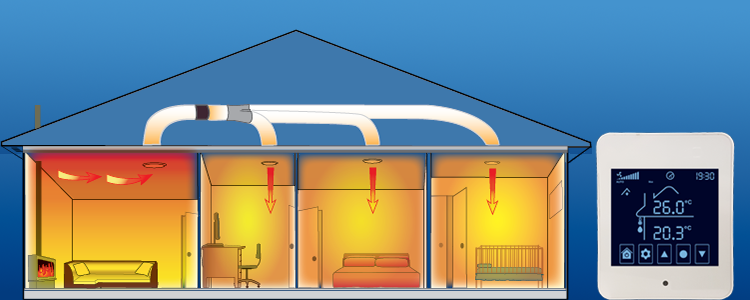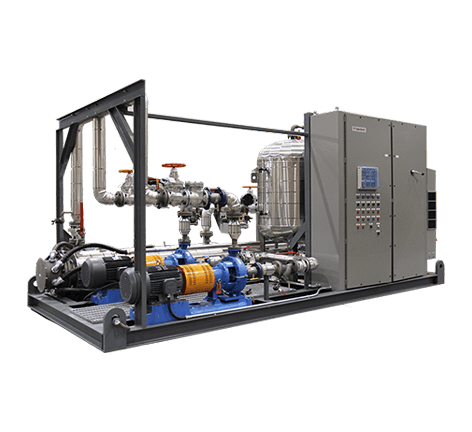How DVS Heat Transfer Systems Are Reshaping Energy Efficiency in Industrial Cooling
Wiki Article
The Duty of Heat Transfer Systems in Sustainable Energy Solutions for the Future
Heat transfer systems are necessary in the pursuit for lasting energy services. They enhance thermal power administration, improving the effectiveness of eco-friendly modern technologies. By employing mechanisms like conduction, convection, and radiation, these systems reduce energy losses. Their function in solar thermal and geothermal applications is especially considerable. As technologies arise, the potential for additional improvements increases crucial concerns regarding future energy techniques. What developments will shape the landscape of sustainable energy?Understanding Heat Transfer Systems

The Significance of Thermal Energy Monitoring
Efficient thermal energy management is vital for maximizing energy efficiency and minimizing waste in numerous systems. By regulating temperature level and maximizing Heat transfer processes, organizations can markedly minimize energy intake and functional costs. Reliable monitoring entails the implementation of sophisticated modern technologies and methods that keep an eye on and manage thermal conditions within systems, making sure that power resources are used effectively. In enhancement, appropriate thermal energy monitoring adds to reducing greenhouse gas exhausts, straightening with international sustainability objectives. It additionally boosts system dependability and performance, causing enhanced item quality and longer equipment life-span. Eventually, prioritizing thermal energy administration is an important step towards producing more sustainable energy services and promoting a liable strategy to power usage in property and commercial contexts.Applications of Heat Transfer in Renewable Resource
While different renewable resource sources promise sustainability, the efficient application of Heat transfer plays an important function in their effectiveness. In wind energy systems, Heat transfer is used for turbine component air conditioning, improving performance and long life. Geothermal power relies upon reliable Heat exchange between the earth's subsurface and the fluid distributing in the system, making best use of power extraction. Biomass energy processes also gain from Heat transfer, as it helps in converting organic products right into functional gas through pyrolysis and gasification. In addition, in hydropower, maintaining excellent temperatures in tanks can enhance energy outcome. Each of these applications demonstrates the critical relevance of Heat transfer systems in enhancing renewable resource modern technologies, eventually contributing to a more sustainable power future.Enhancing Solar Thermal Power Performance
As solar thermal power systems continue to progress, improving their efficiency has actually come to be crucial for making best use of power result. Advances in Heat transfer innovations, such as enhanced thermal storage materials and innovative Heat exchangers, play a substantial function in improving efficiency. By utilizing advanced materials that have superior thermal conductivity, systems can record and move Heat better. Additionally, integrating radar that adhere to the sunlight's course assurances that enthusiasts get ideal solar direct exposure throughout the day. Using nanotechnology in solar absorbers can even more increase power absorption prices. Including automatic control systems aids control temperatures and handle energy circulation efficiently, leading to lowered losses and enhanced total system efficiency. These improvements pave the means for more lasting solar thermal energy options in the future.Geothermal Home Heating: A Sustainable Remedy
Geothermal heating offers a practical alternative for sustainable power, providing considerable environmental advantages with reduced greenhouse gas discharges. Its performance and cost-effectiveness make it an appealing choice to conventional home heating systems. However, difficulties connected to implementation should be dealt with to optimize its potential effect.Ecological Advantages of Geothermal
Although traditional heating methods contribute considerably to greenhouse gas emissions, geothermal home heating offers an engaging choice that decreases ecological effect. By harnessing the Planet's interior Heat, geothermal systems utilize a renewable resource resource, markedly reducing dependence on fossil gas. This technique generates minimal carbon exhausts, making it a cleaner alternative for industrial and residential home heating. In addition, geothermal systems promote power efficiency, as they call for less power compared to traditional heater. DVS Heat Transfer Systems. The use of geothermal power additionally assists in decreasing air pollution, improving local air top quality and public wellness. As a sustainable option, geothermal home heating supports environment change reduction efforts, placing itself as a necessary part in the change towards a greener futurePerformance and Cost-Effectiveness
Exactly how does geothermal home heating determine up in regards to efficiency and cost-effectiveness contrasted to traditional heating unit? Geothermal heating demonstrates premium effectiveness, often accomplishing a coefficient of efficiency (POLICE OFFICER) of 3 to 5, suggesting it creates 3 to five systems of Heat for each unit of power consumed. This performance translates into reduced operating costs, particularly in areas with stable geothermal resources. First installation costs can be greater than standard systems; nevertheless, long-lasting financial savings on energy expenses and lowered maintenance expenses can balance out these ahead of time investments. Furthermore, several governments incentivize geothermal systems with discounts and tax credit reports, improving their cost-effectiveness. Generally, geothermal home heating emerges as a economically sensible and lasting choice to even more conventional heating remedies.Implementation Challenges and Solutions
Various difficulties can restrain the prevalent execution of geothermal heating unit, despite their clear advantages as a sustainable energy solution. High initial installation costs frequently discourage house owners and capitalists, making funding a considerable barrier. Furthermore, the geographical restrictions of suitable geothermal websites restrict ease of access in certain areas. Neighborhood guidelines and permitting processes can additionally make complex job advancement, leading to hold-ups. Public understanding and understanding of geothermal systems continue to be reduced, hindering approval. To attend to these difficulties, targeted education projects can enhance open secret, while federal government rewards can ease financial concerns. Working together with local authorities to improve policies may assist in smoother job approvals, inevitably advertising the fostering of geothermal home heating as a practical, sustainable energy option.Innovations in Heat Transfer Technologies
Technologies in Heat transfer modern technologies play a crucial duty in enhancing power efficiency and sustainability. Advanced Heat exchangers and phase modification materials go to the leading edge of these developments, using substantial enhancements in thermal monitoring. These innovations not just enhance power use however additionally contribute to minimizing environmental effect in numerous applications.Advanced Heat Exchangers
Advanced Heat exchangers play an essential function in boosting power efficiency across different applications in lasting power services. These gadgets promote the transfer of Heat between two or more fluids, noticeably reducing energy usage in processes such as commercial home heating, air conditioning, and power generation. Innovations in materials and design, such as making use of nanofluids and small arrangements, have actually caused boosted thermal efficiency and lowered size requirements. Additionally, developments in digital tracking and control systems enable for enhanced operation, additional boosting effectiveness. By lessening waste Heat and maximizing energy recovery, progressed Heat exchangers add to decrease carbon impacts and support the shift towards eco-friendly technologies. Their continued growth is important for attaining international energy sustainability objectives.
Phase Modification Products
The assimilation of stage modification materials (PCMs) into Heat transfer technologies stands for a substantial innovation in power monitoring and effectiveness. PCMs take in and release thermal power during their phase changes, allowing effective temperature level guideline in structure materials and energy systems. By keeping excess Heat during optimal durations and releasing it when demand rises, PCMs add to load changing and power conservation - DVS Heat Transfer Systems. This capacity improves the performance of eco-friendly energy systems, specifically in solar thermal DVS Heat Transfer Systems applications. Furthermore, PCMs can improve the thermal convenience of indoor settings, minimizing reliance on conventional home heating and cooling methods. As advancements in PCM solutions continue to arise, their function in lasting energy solutions is poised to grow, offering encouraging opportunities for future study and application
Future Leads for Heat Transfer in Lasting Energy
As the demand for sustainable power remedies proceeds to climb, the function of Heat transfer systems is coming to be significantly essential in forming future modern technologies. Advancements in designs and materials are expected to enhance performance in Heat transfer, decreasing energy losses in numerous applications. The integration of advanced thermal storage space systems, such as phase adjustment products and thermochemical storage, will certainly make it possible for much better administration of power sources. Research right into nanofluids and biomimetic Heat exchangers may additionally optimize thermal efficiency. Moreover, the adoption of smart innovations will permit real-time monitoring and flexible control of Heat transfer procedures. These developments are positioned to considerably add to the general effectiveness and sustainability of power systems, leading the way for an extra energy-efficient future.Frequently Asked Concerns
Exactly How Can People Execute Heat Transfer Systems in the house?

Individuals can execute Heat transfer systems in the house by installing energy-efficient appliances, using radiant home heating, and enhancing insulation. These procedures boost power effectiveness, lower expenses, and promote lasting methods in domestic atmospheres.

What Are the Costs Connected With Mounting Heat Transfer Solutions?
The costs connected with mounting Heat transfer systems differ widely, normally including tools, setup labor, and upkeep. Aspects such as system kind, home size, and neighborhood guidelines considerably affect the overall expense entailed.Are There Federal Government Incentives for Heat Transfer System Installations?
Federal government motivations for Heat transfer system installments vary by region and can include tax gives, discounts, and debts. These economic benefits intend to motivate fostering, inevitably advertising energy performance and minimizing ecological impact within neighborhoods.Just How Do Heat Transfer Solutions Effect Power Bills?
Heat transfer systems especially influence energy expenses by maximizing energy effectiveness. By improving the transfer of Heat, these systems minimize power consumption, causing reduced energy costs and producing a much more sustainable technique to power management.What Maintenance Is Required for Heat Transfer Solutions?
Upkeep for Heat transfer systems consists of routine examinations, cleansing of components, checking fluid levels, making sure correct insulation, and changing used parts. These jobs assist keep performance, protect against breakdowns, and prolong the system's operational life expectancy.These systems help with the activity of thermal power from one tool to an additional, making it possible for the transfer of Heat for cooling, power, or home heating generation purposes. Geothermal power depends on efficient Heat exchange between the planet's subsurface and the liquid flowing in the system, making best use of power removal. Furthermore, geothermal systems promote energy performance, as they call for much less energy compared to conventional home heating systems. Advanced Heat exchangers play a crucial duty in improving energy efficiency throughout different applications in sustainable power remedies. Heat transfer systems significantly influence power expenses by optimizing power performance.
Report this wiki page